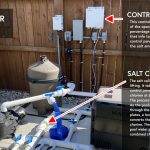Siphoning water from a pond can be a useful skill for various purposes such as cleaning, irrigation, or water transfer. In this guide, we will walk you through the steps to effectively siphon water from a pond using simple tools and techniques.
Tools and Equipment Needed
Before you begin siphoning water from a pond, make sure you have the following tools and equipment ready:
- Flexible tubing or hose
- Bucket or container
- Water source (the pond)
- Gravity – for the siphoning action

Credit: aquascape.net
Step-by-Step Guide to Siphon Water from a Pond
Step 1: Prepare Your Equipment
Ensure that the flexible tubing or hose is clean and free from any blockages. The length of the tubing should be long enough to reach from the pond to the desired location where you want to transfer the water.
Step 2: Submerge The Tubing
Submerge one end of the tubing into the pond, making sure it is completely filled with water. You can weigh down this end with a small rock or any heavy object to keep it in place.
Step 3: Create The Siphon
With one end of the tubing in the pond, place the other end of the tubing at a lower elevation than the pond surface. This height difference will create the siphoning effect needed to draw the water out of the pond.
Step 4: Start The Siphoning Process
To start the siphoning process, you can either suck on the end of the tubing to initiate the flow of water or use a pump to create the initial suction. Once the water starts flowing, gravity will take over and continue the siphoning process.
Step 5: Monitor The Flow
Keep an eye on the water flow and ensure that the end of the tubing remains submerged in the pond. If the flow stops at any point, you may need to restart the siphoning process by creating suction again.
Step 6: Transfer The Water
Direct the flowing water into a bucket or container at the desired location. You can adjust the flow rate by raising or lowering the end of the tubing to control the amount of water being siphoned.
Tips and Safety Precautions
- Do not drink or ingest water that has been siphoned from a pond as it may contain harmful bacteria or contaminants.
- Make sure the tubing is securely connected and does not come loose during the siphoning process.
- Avoid siphoning water from ponds with stagnant water or visible signs of pollution.
- Regularly clean and disinfect the tubing after each use to prevent the growth of harmful bacteria.
- Always be cautious when working with water and ensure you have a safe and stable setup to prevent accidents.

Credit: m.youtube.com
Conclusion
Siphoning water from a pond can be a simple and effective way to transfer water for various purposes. By following the steps outlined in this guide and taking necessary safety precautions, you can easily siphon water from a pond with minimal tools and effort. Remember to always be mindful of the source of the water and use the transferred water appropriately.




